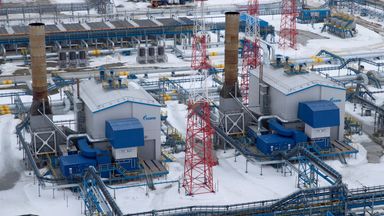BATON ROUGE, La. (AP) — In an effort to reduce greenhouse gas emissions, Louisiana officials announced on Monday two new projects that are expected to remove hundreds of thousands of tons of carbon dioxide from the air per year and store it deep underground.
The new sites are the latest in a slew of carbon removal and storage projects that have been announced in Louisiana, a state that has had a front row seat to the impacts of climate change. Proponents say this type of technology is crucial in the fight against climate change. But critics argue that carbon capture could distract from other, more effective, efforts to reduce emissions and could prolong the lifespan of fossil fuel use.
Carbon removal and storage facilities — which capture airborne carbon emissions created during industrial production and store them permanently deep underground — have gained traction and garnered debate in Louisiana in recent years.
Advocates of the industry say that the practice is a safe way to reduce the state’s industrial emissions.
In a November 2021 report from the U.N. Intergovernmental Panel on Climate Change, the world’s top scientists said carbon capture and storage technology has to be part of the range of solutions to decarbonize and mitigate climate change. But they notably added that solar and wind energy and electricity storage are improving faster than carbon capture and storage.
Opponents have pointed to oil companies investing in the projects, saying that it could prolong the lifespan of fossil fuel use. In Louisiana in 2022, ExxonMobil, CF Industries and EnLink Midstream entered into an agreement to remove 2 million metric tons of carbon dioxide annually.
Other carbon capture projects have drawn ire from residents, specifically worrying about the storage sites and if it could pose a threat to the public health of nearby communities, some of which have long been plagued by air and water pollution. However, officials say there are safeguards in place to monitor the process and infrastructure.
And while the removal of 320,000 tons of carbon dioxide is minute to the billions of metric tons of carbon pollution poured into the air each year, advocates of the technology say any little bit helps.
“It is a drop in the bucket, but more importantly this is a blueprint and template that can be replicated in every city, every state, every country and every continent across the world,” said Shashank Samala, the CEO of Heirloom, the “direct air capture” company that will build two facilities in northwest Louisiana.
While Samala recognizes that a single facility — whether it be carbon capture, a solar farm or wind farm — will not solve climate change, he said it is an “all hands on deck effort” and hopes the industry continues to grow.
Louisiana in particular has deeply felt the impacts of climate change.
Over the past two decades in the Bayou State, hurricanes have made landfall more frequently, coastal areas have been eaten away by erosion, subsidence and rising sea levels, and the Mississippi River reached record-low water levels, causing barges with agricultural exports to get stuck.
Louisiana, which shares its southern border with the Gulf of Mexico, also relies on the oil and gas industry with tens of thousands of jobs tied to it. In 2021, Louisiana was ranked third among the top natural gas-producing states — accounting for nearly 10% of the United States’ natural gas production that year, behind only Texas and Pennsylvania. In addition, Louisiana had the fourth most energy-related carbon dioxide emissions per capita in 2021, according to data from the U.S. Energy Information Administration.
Heirloom estimates that they will eventually remove 320,000 tons of carbon dioxide each year — equivalent to what would be produced by more than 76,000 gas-powered cars driven for one year, according to the Environmental Protection Agency.
The company uses limestone, a natural absorbent, to extract carbon dioxide from the air. Heirloom’s technology reduces the time it takes to absorb carbon dioxide in nature from years to just three days, according to the company’s press release. The carbon dioxide is then removed from the limestone material and stored permanently underground.
The new Louisiana facilities will be located at the Port of Caddo-Bossier in Shreveport. The first facility will be operational in 2026 and the larger facility will startup in 2027.
The underground storage site for the captured carbon dioxide is still being determined.
Disclaimer: The copyright of this article belongs to the original author. Reposting this article is solely for the purpose of information dissemination and does not constitute any investment advice. If there is any infringement, please contact us immediately. We will make corrections or deletions as necessary. Thank you.



